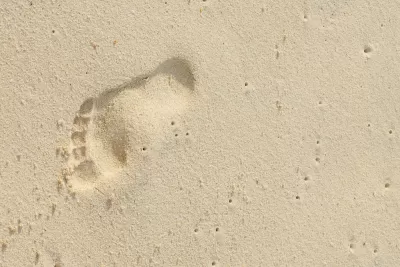For decades, New Jersey's coastal communities have been the beneficiaries of artificial beach nourishment, at great expense. After Sandy washed away hundreds of million of dollars of sand, some are suggesting it's time for a strategic retreat.

Superstorm Sandy has turned a spotlight on the long simmering debate over the artificial maintenance of beaches along New Jersey's coast with sand pumped from offshore. After Sandy swept away "enormous quantities of sand," both proponents and opponents of "artificial beach nourishment" are reconsidering the practice, reports Cornelia Dean.
"Opponents of beach nourishment argue that undeveloped beaches deal well with storms. Their sands shift; barrier islands may even migrate toward the mainland. But the beach itself survives, because buildings and roads do not pin it down," says Dean. "By contrast, replenishment projects often wash away far sooner than expected. The critics say the best answer to coastal storms is to move people and buildings away from the water, a tactic some call strategic retreat."
"Supporters of these projects counter that beaches are infrastructure - just like roads, bridges and sewer systems - that must be maintained. They say beaches attract tourists and summer residents, conferring immense economic benefits that more than outweigh the costs of the projects. Also, they argue, these beaches absorb storm energy, sparing buildings inland."
FULL STORY: Costs of Shoring Up Coastal Communities

Maui's Vacation Rental Debate Turns Ugly
Verbal attacks, misinformation campaigns and fistfights plague a high-stakes debate to convert thousands of vacation rentals into long-term housing.

Planetizen Federal Action Tracker
A weekly monitor of how Trump’s orders and actions are impacting planners and planning in America.

San Francisco Suspends Traffic Calming Amidst Record Deaths
Citing “a challenging fiscal landscape,” the city will cease the program on the heels of 42 traffic deaths, including 24 pedestrians.

Defunct Pittsburgh Power Plant to Become Residential Tower
A decommissioned steam heat plant will be redeveloped into almost 100 affordable housing units.

Trump Prompts Restructuring of Transportation Research Board in “Unprecedented Overreach”
The TRB has eliminated more than half of its committees including those focused on climate, equity, and cities.

Amtrak Rolls Out New Orleans to Alabama “Mardi Gras” Train
The new service will operate morning and evening departures between Mobile and New Orleans.
Urban Design for Planners 1: Software Tools
This six-course series explores essential urban design concepts using open source software and equips planners with the tools they need to participate fully in the urban design process.
Planning for Universal Design
Learn the tools for implementing Universal Design in planning regulations.
Heyer Gruel & Associates PA
JM Goldson LLC
Custer County Colorado
City of Camden Redevelopment Agency
City of Astoria
Transportation Research & Education Center (TREC) at Portland State University
Jefferson Parish Government
Camden Redevelopment Agency
City of Claremont





























